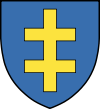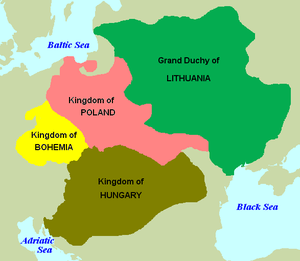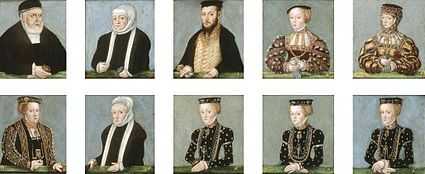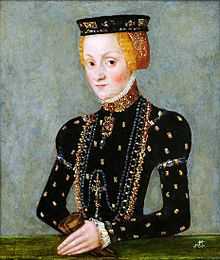Jagiellonian dynasty
| Jagiellonian dynasty | |
|---|---|
 | |
| Country |
|
| Parent house | Gediminids |
| Titles |
King of Poland King of Hungary King of Bohemia Grand Duke of Lithuania |
| Founded | 1386 |
| Founder | Władysław II Jagiełło |
| Final ruler | Anna Jagiellon of Poland |
| Dissolution | 1572 |

The Jagiellonian dynasty was a royal dynasty, founded by Jogaila, the Grand Duke of Lithuania, who in 1386 was baptized as Władysław, married Queen (strictly King)[1] Jadwiga of Poland, and was crowned King of Poland as Władysław II Jagiełło. The dynasty reigned in several Central European countries between the 14th and 16th centuries. Members of the dynasty were Kings of Poland (1386–1572), Grand Dukes of Lithuania (1377–1392 and 1440–1572), Kings of Hungary (1440–1444 and 1490–1526), and Kings of Bohemia (1471–1526).
The personal union between the Kingdom of Poland and the Grand Duchy of Lithuania (converted in 1569 with the Treaty of Lublin into the Polish–Lithuanian Commonwealth) is the reason for the common appellation "Poland–Lithuania" in discussions about the area from the Late Middle Ages onward. One Jagiellonian briefly ruled both Poland and Hungary (1440–44), and two others ruled both Bohemia and Hungary (1490–1526) and then continued in the distaff line as the Eastern branch of the House of Habsburg.
Name
The name comes from Jagiełło, the first Grand Duke of Lithuania to become King of Poland. In Polish, the dynasty is known as Jagiellonowie and the patronymic form: Jagiellończyk; in Lithuanian it is called Jogailaičiai, in Belarusian Яґайлавічы (Jagajłavičy), in Hungarian Jagelló, and in Czech Jagellonci, as well as Jagello or Jagellon in Latin.
Pre-dynasty background
The rule of Piasts, the earlier Polish ruling house (c. 962–1370) had ended with the death of King Casimir III the Great. Gediminids, the immediate predecessors of the first Jagiellonian, were rulers of medieval Lithuania with the title of Grand Duke. Their realm, the Grand Duchy of Lithuania, was chiefly inhabited by Lithuanians and Ruthenians.
Jogaila, the eponymous first ruler of the Jagiellonin dynasty, started as the Grand Duke of Lithuania. As a result of the Union of Krewo he then converted to Christianity and married the 11-year-old Hedwig of Poland (Jadwiga in Polish) (daughter of King Louis I of Hungary from the Angevins Dynasty). Thereby he became King of Poland and founded the dynasty. Angevin rulers were the second and Jagiellonian third dynasty of Polish Kings.
Jagiellonian Kings of Poland

| Portrait | Name | Born | Died | Reign | Spouse |
|---|---|---|---|---|---|
| Władysław II Jagiełło | ca. 1362 | 1434 | 1386–1434 | Jadwiga of Poland Anne of Cilli Elisabeth of Pilica Sophia of Halshany | |
 | Władysław III of Poland | 1424 | 1444 | 1434–1444 Poland 1440–1444 Hungary | none |
| Casimir IV Jagiellon | 1427 | 1492 | 1447–1492 | Elisabeth of Austria | |
 | John I Albert | 1459 | 1501 | 1492–1501 | none |
| Alexander I Jagiellon | 1461 | 1506 | 1501–1506 | Helena of Moscow | |
| Sigismund I the Old | 1467 | 1548 | 1507–1548 | Barbara Zápolya Bona Sforza | |
| Sigismund II Augustus | 1520 | 1572 | 1530/1548-1572 | Elisabeth of Austria Barbara Radziwiłł Catherine of Austria |
After Sigismund II Augustus, the dynasty underwent further changes. Sigismund II's heirs were his sisters Anna Jagiellon and Catherine Jagiellon. The latter had married Duke John of Finland, who thereby from 1569 became King John III of Sweden, and they had a son, Sigismund III Vasa; as a result, the Polish branch of the Jagiellonians merged with the House of Vasa, which ruled Poland from 1587 until 1668. During the interval, among others, Stephen Báthory, the husband of the childless Anna, reigned.
Jagiellonian Kings of Bohemia, Hungary and Croatia
At one point, the Jagiellonians established dynastic control also over the kingdoms of Bohemia and Hungary (from 1490 onwards), with Vladislaus Jagiello whom several history books call Vladisla(u)s II. After being elected and crowned King of Hungary, Vladislaus moved his court to Hungary from where he ruled both countries and his children were born and raised. By Louis' sudden death in Battle of Mohács in 1526, that royal line was extinguished in male line.
| Portrait | Name | Born | Died | Reign | Spouse |
|---|---|---|---|---|---|
 | Vladislaus II of Bohemia and Hungary | 1456 | 1516 | 1471–1516 Bohemia 1490–1516 Hungary and Croatia | Barbara of Brandenburg Beatrice of Naples Anne of Foix-Candale |
 | Louis II of Hungary and Bohemia | 1506 | 1526 | 1516–1526 Bohemia, Hungary, Croatia | Mary of Austria |
Other members of the Jagiellonian dynasty
Legacy
- The Jagiellonian University in Kraków
- Jagiellonian Library of the Jagiellonian University in Kraków
- Globus Jagellonicus, is by some considered to be the oldest existing globe to show the Americas
- Jagiellonian tapestries is a collection of tapestries
- Jagiellonia Białystok, a football club, based in Białystok
- Jagiellonia Tuszyn, a former football club based in Tuszyn
- Jagiełło Oak, most noted of the Białowieża Forest oaks
- Jagiellonia, a fraternal society founded in 1910 in Vienna
See also
- History of Poland during the Jagiellon dynasty
- List of Polish rulers
- List of Czech rulers
- List of Hungarian rulers
- List of Lithuanian rulers
| Vladislaus II (Jogaila)[lower-roman 1] ca.1351–1434 G. Duke of Lithuania, 1377–1401 King of Poland, 1386–1434 | |||||||||||||||||||||||||||||||||||||||||||||||||||||||||||||||||||||||||||||||||||||||||||||||||||||||
| Elisabeth Bonifacia 1399 | Hedwig 1408–1431 | Vladislaus III 1424–1444 King of Poland, 1434–1444 King of Hungary, 1440–1444 | Casimir 1426–1427 | Casimir IV 1427–1492 G. Duke of Lithuania, 1440–1492 King of Poland, 1447–1492 | |||||||||||||||||||||||||||||||||||||||||||||||||||||||||||||||||||||||||||||||||||||||||||||||||||
| Vladislaus II 1456–1516 King of Bohemia, 1471–1516 King of Hungary, 1490–1516 | Hedwig 1457–1502 Duchess of Bavaria-Landshut, 1475–1502 | Saint Casimir 1458–1484 | John I Albert 1459–1501 King of Poland, 1492–1501 | Alexander 1461–1506 G. Duke of Lithuania, 1492–1506 King of Poland, 1501–1506 | Sophia 1464–1512 Margravine of Brandenburg-Ansbach, 1479–1512 | Elisabeth 1465–1466 | Sigismund I 1467–1548 King of Poland and G. Duke of Lithuania, 1506–1548 | Frederick 1468–1503 Bishop of Kraków, 1488–1503 Archbishop of Gniezno, 1493–1503 | Elisabeth 1472–after 1480 | Anna 1476–1503 Duchess of Pomerania, 1491–1503 | Barbara 1478–1534 Margravine of Meissen, 1494–1534 | Elisabeth ca.1483–1517 Duchess of Liegnitz, 1515–1517 | |||||||||||||||||||||||||||||||||||||||||||||||||||||||||||||||||||||||||||||||||||||||||||
| Anna 1503–1547 Queen of Hungary and Bohemia, 1526–1547 Queen of the Romans, 1531–1547 | Louis II 1506–1526 King of Hungary and Bohemia, 1516–1526 | Hedwig 1513–1573 Electress of Brandenburg, 1535–1573 | Anna 1515–1520 | Isabella 1519–1559 Queen of Hungary, 1539–1540 | Sigismund II Augustus 1520–1571 King of Poland and G. Duke of Lithuania, 1548–1572 | Sophia 1522–1575 Duchess of Brunswick- Wolfenbüttel, 1556–1568 | Anna 1523–1596 Queen of Poland and G. Duchess of Lithuania, 1575–1586 | Catherine 1526–1583 Duchess of Finland, 1562–1583 Queen of Sweden, 1569–1583 | |||||||||||||||||||||||||||||||||||||||||||||||||||||||||||||||||||||||||||||||||||||||||||||||
Notes:
- ↑ kings are marked in gold, queens – in pale gold.
Bibliography
- Małgorzata Duczmal, Jagiellonowie. Leksykon biograficzny, Kraków 1996.
- Stanisław Grzybowski, Dzieje Polski i Litwy (1506–1648), Kraków 2000. ISBN 83-85719-48-2
- Paweł Jasienica, Polska Jagiellonów (1963), ISBN 978-83-7469-522-0
- Wojciech Dominiak, Bożena Czwojdrak, Beata Jankowiak-Konik, Jagiellonowie
- Marek Derwich, Monarchia Jagiellonów (1399–1586)
- Krzysztof Baczkowski, Polska i jej sąsiedzi za Jagiellonów
References
- ↑ Jadwiga was crowned King of Poland — Hedvig Rex Poloniæ, not Hedvig Regina Poloniæ. Polish law had no provision for a female ruler (queen regnant), but did not specify that the King had to be a male. The masculine gender of her title was also meant to emphasize that she was monarch in her own right, not a queen consort.
External links
| Wikimedia Commons has media related to House of Jagiellon. |
- Rulers of Poland
- Jagiellonian Dynasty
- Pages and Forums on Lithuanian history
- Jagiellonian Observatory
| ||||||||||||||||||||||||||||||||||||||||||





.jpg)





